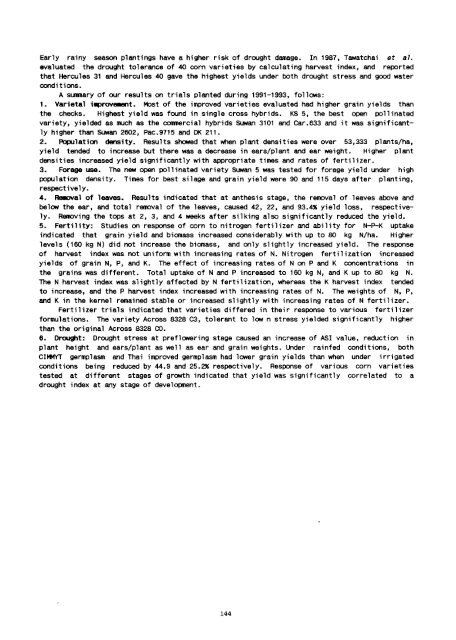Proceedings of the Fifth Asian Regional Maize Workshop - Search ...
Proceedings of the Fifth Asian Regional Maize Workshop - Search ...
Proceedings of the Fifth Asian Regional Maize Workshop - Search ...
Create successful ePaper yourself
Turn your PDF publications into a flip-book with our unique Google optimized e-Paper software.
Early rainy season plantings have a higher risk <strong>of</strong> drought damage. In 1987, Tawatchai at a7.<br />
evaluated <strong>the</strong> drought tolerance <strong>of</strong> 40 corn varieties by calculating harvest index, and reported<br />
that Hercules 31 and Hercules 40 gave <strong>the</strong> highest yields under both drought stress and good water<br />
conditions.<br />
A summary <strong>of</strong> our results on trials planted during 1991-1993, follows:<br />
1. Varietal i~roveMent. Most <strong>of</strong> <strong>the</strong> improved varieties evaluated had higher grain yields than<br />
<strong>the</strong> checks. Highest yield was found in single cross hybrids. KS 5, <strong>the</strong> best open pollinated<br />
variety, yielded as much as <strong>the</strong> commercial hybrids SUWan 3101 and car.633 and it was significantly<br />
higher than Suwan 2602, Pac.9715 and OK 211-<br />
2. Population density. Results showed that when plant densities were over 53,333 p1ants/ha,<br />
yield tended to increase but <strong>the</strong>re was a decrease in ears/plant and ear weight. Higher plant<br />
densities increased yield significantly with appropriate times and rates <strong>of</strong> fertilizer.<br />
3. Forage use. The new open pollinated variety Suwan 5 was tested for forage yield under high<br />
population density. Times for best silage and grain yield were 90 and 115 days after planting,<br />
respectively.<br />
4. Removal <strong>of</strong> leaves. Results indicated that at an<strong>the</strong>sis stage, <strong>the</strong> removal <strong>of</strong> leaves above and<br />
below <strong>the</strong> ear, and total removal <strong>of</strong> <strong>the</strong> leaves, caused 42, 22, and 93.4~ yield loss, respectively.<br />
Removing <strong>the</strong> tops at 2, 3, and 4 weeks after silking also significantly reduced <strong>the</strong> yield.<br />
5. Fertility: Studies on response <strong>of</strong> corn to nitrogen fertilizer and ability for N-P-K uptake<br />
indicated that grain yield and biomass increased considerably with up to 80 kg N/ha. Higher<br />
levels (160 kg N) did not increase <strong>the</strong> biomass, and only slightly increased yield. The response<br />
<strong>of</strong> harvest index was not uniform with increasing rates <strong>of</strong> N. Nitrogen fertilization increased<br />
yields <strong>of</strong> grain N, P, and K. The effect <strong>of</strong> increasing rates <strong>of</strong> N on P and K concentrations in<br />
<strong>the</strong> grains was different. Total uptake <strong>of</strong> N and P increased to 160 kg N, and K up to 80 kg N.<br />
The N harvest index was slightly affected by N fertilization, whereas <strong>the</strong> K harvest index tended<br />
to increase, and <strong>the</strong> P harvest index increased with increasing rates <strong>of</strong> N. The weights <strong>of</strong> N, P,<br />
and K in <strong>the</strong> kernel remained stable or increased slightly with increasing rates <strong>of</strong> N fertilizer.<br />
Fertilizer trials indicated that varieties differed in <strong>the</strong>ir response to various fertilizer<br />
formulations. The variety Across 8328 C3, tolerant to low n stress yielded significantly higher<br />
than <strong>the</strong> original Across 8328 CO.<br />
6. D~t: Drought stress at pref10wering stage caused an increase <strong>of</strong> ASI value, reduction in<br />
plant height and ears/plant as well as ear and grain weights. Under rainfed conditions, both<br />
CIMMYT germp1asm and Thai improved germp1asm had lower grain yields than when under irrigated<br />
conditions being reduced by 44.9 and 25.~ respectively. Response <strong>of</strong> various corn varieties<br />
tested at different stages <strong>of</strong> growth indicated that yield was significantly correlated to a<br />
drought index at any stage <strong>of</strong> development.<br />
144

















